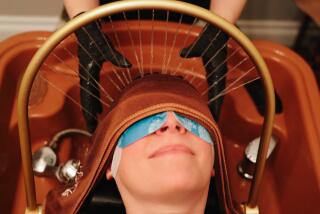Researchers discover trick to regrowing lost hair
Frustrated by hair loss? New research suggests a peculiar, and slightly painful, solution to the ancient condition of baldness: Yank out whatever hair you have left.
In a paper published Thursday in the journal Cell, researchers say they provoked fur regeneration in mice by plucking hairs in a precise pattern and concentration.
Not only did the plucked hairs grow back, but new hairs sprouted nearby, researchers said.
“The work leads to potential new targets for treating alopecia, a form of hair loss,” said senior study author Cheng-Ming Chuong, a stem cell researcher at USC.
But don’t start ripping out your hair just yet. Researchers say the growth occurred only when many hairs were pulled in an area slightly smaller than the diameter of a pencil eraser.
“By varying the spacing, arrangement, and shapes of plucked regions, we unexpectedly found that plucking 200 hairs, with a proper distribution can cause up to 1,200 hairs to regenerate,” authors wrote.
So what’s the deal?
Chuong and his colleagues say this unexpected hair growth probably is the result of “quorum sensing,” the process by which cells communicate with one another chemically, alerting others to damage and requesting help.
The hair plucking phenomenon “may just be one of the examples that reveal collective cellular behaviors in response to physiological or pathological stimuli,” the authors wrote. “We believe that the quorum sensing behavior principle is likely to be present in the regeneration of tissue and organs beyond the skin.”
The researchers used genetic and molecular analysis to determine what occurs when mouse hairs are plucked.
At first, follicles release inflammatory proteins, or cytokines, which alert the immune system to a wound, researchers say.
The immune system responds by sending macrophages to the problem area. Macrophages are white blood cells that engulf and devour pathogens, but they also release cytokines that can trigger a variety of responses in cells, such as causing them to proliferate.
In this particular situation, macrophages will secrete signaling molecules called tumor necrosis factor alpha, which at certain levels, will prompt plucked and unplucked follicles to grow hair.
A robust regenerative response seemed to be dependent on the density of signaling behaviors, researchers said.
For example, when researchers plucked mouse hairs in a diffuse pattern, in an area with a diameter larger than 6 millimeters, no hairs regenerated.
But when a dense concentration of hairs were pulled in an area 3 to 5 millimeters across, the plucked hairs grew back and new hairs sprouted nearby.
“The quorum sensing circuit we describe here provides a way for injured hair follicles to collectively assess the magnitude and extent of injury that the skin has sustained and make an all-or-none decision whether or not to regenerate.”
Follow @montemorin for science news







